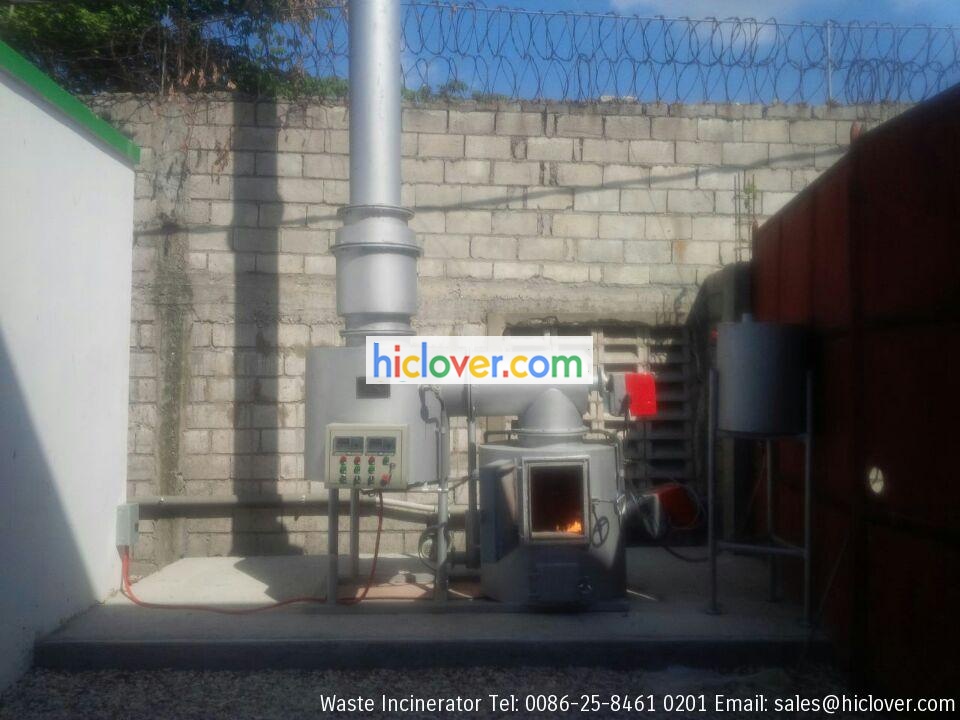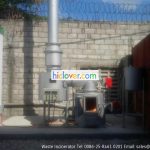Doubel Combustion Chamber
All Incinerators are Doubel Combustion Chamber with One Fuel Burner Each. After Burner Technology for Completely Combustion and Cleaner World.
Read MoreHigh Temperature Incineration
Temperature Range 800 Degree to 1200 Degree in Combustion Chamber. Temperature Thermocouple Monitor and Controller. High Quality Fire Brick and Refactory Cement.
Read MoreGet Lastest News
There are latest incinerator news like technical, public news, business tender for medical waste incinerator,animal incineration, pet cremation
Read MoreNanjing Clover Medical Technology Co.,Ltd.
Email: sales@clover-incinerator.com | Tel: +86-25-8461 0201
Regular model incinerator for market with burning rate from 10kgs to 500kgs per hour and we always proposal customer send us their require details, like waste material, local site fuel and power supply, incinerator operation time, etc, so we can proposal right model or custom made with different structure or dimensions.
Incinerator Model YD-100 is a middle scale incineration machine for many different usage: for a middle hospital sickbed below 500 units, for all small or big size family pets (like Alaskan Malamute Dog), for community Municipal Solid Waste Incineration, etc. The primary combustion chamber volume is 1200Liters (1.2m3) and use diesel oil or natural gas fuel burner original from Italy.
Latest Post
Pyrolysis Deemed a Viable Alternative to Incinceration
Researchers at the University of York have concluded that PyroPure (UK) technology has the potential to transform the way in which hazardous waste is destroyed in clinical environments and say pharmacists, manufacturers and hospitals across the UK should consider trialling the system.
The announcement follows a six month Innovate UK-funded Knowledge Transfer Partnership project in which a team of leading scientists in the University’s Environment Department and Centre of Excellence in Mass Spectroscopy verified that the system helped to destroy active pharmaceutical ingredients (APIs) found within pharmaceutical waste onsite.
A total of 17 of the most thermally resistant APIs were selected for the trial, which revealed that PyroPure technology destroys over 99 percent of APIs in 10 of the 17 tested and an average of 94 percent of the’worst case’ pharmaceuticals. In the future of PyroPure as an alternative to high temperature incineration, he remarks:
“There are big concerns over the negative effects of pharmaceuticals on the natural environment. Inappropriate disposal of pharmaceuticals and emissions from manufacturing sites are regarded as important contributors to those impacts. Our work shows that PyroPure could help reduce the levels of pharmaceuticals in rivers and streams and also have big benefits for ecosystem health. The system also provides a selection of other environmental and economic benefits that could radically change how waste of this nature is collected and destroyed going forward. With PyroPure technology, hazardous waste and controlled substances no longer need to be transported across the country to incineration facilities, thus reducing the related costs, carbon emissions and risks related to transferring waste from its point of origin to its point of disposal.”
Currently in the UK, pharmaceutical wastes are only disposed of in large-scale, high-temperature incinerators, which can be up to 200 miles away from where the waste is generated. The Environment Agency has indicated that PyroPure, which is based on pyrolysis, a thermochemical decomposition procedure using high temperatures and an absence of oxygen, followed by catalytic conversion to clean and convert the gases, could be the first viable alternative to high-temperature incineration for pharmaceutical wastes.
On the trial’s success, Peter Selkirk, PyroPure Ltd’s Executive Chairman, adds:”This is a huge step forward for PyroPure technology as well as the healthcare industry. For too long now, we’ve been overly dependent on incineration as the only viable route in which to dispose of hazardous waste. Not only is it expensive but it’s also open to security breaches, particularly when the waste has to be transported long distances. Now that PyroPure is a proven technology I’m convinced that this breakthrough will pave the way for a new approach to waste disposal and irrevocably change the version for waste collection within clinical environments across the world.”
The trial, which formed a Knowledge Transfer Partnership between PyroPure Ltd and the University, also revealed how onsite energy recovery during the PyroPure procedure is at least 75 percent compared with 20 percent for a high-temperature incinerator. The user simply opens the device’s lid and puts the waste within the chamber before initiating the process of pyrolysis to destroy it.
The trial, which formed a Knowledge Transfer Partnership between PyroPure Ltd and the University, also revealed how on-site energy recovery during the PyroPure process is at least 75 per cent compared with 20 per cent for a high-temperature incinerator.
Each PyroPure unit is the size of a chest freezer. The user simply opens the unit’s lid and places the waste within the chamber before initiating the process of pyrolysis to destroy it.
England’s trash Producing Danish heat
Incinerators in Aalborg and Hjørring will also be burning British trash.
“The heating we create using the waste is cheaper than that which we can generate with natural gas,” said AVØ mind Tore Vedelsdal. “And the British are interested because they lack incinerators and pay heavy taxes .”
Vedelsdal said that the ecological angle works for both nations.
“They save on having to bury the waste and we save on the usage of natural gas,” he said.
READ MORE: Denmark pays for electricity
Environmental protection agency Miljøstyrelsen said that last year up to 200,000 tonnes of non-hazardous waste from England was incinerated in Denmark — almost six percent of the whole quantity of combustible material used.
by: http://cphpost.dk/news/englands-trash-generating-danish-heat.11398.html
Power in Denmark is increasingly being generated in plants burning waste imported from England. The tradition has been called an economical and ecological boon on either side of the equation.
The AVØ incinerator in Frederikshavn produces heating and electricity to the region by burning trash from England.
“It is mainly construction waste like bits of wood, cardboard and plastic from Manchester,” AVØ operations manager Orla Frederiksen told DR Nyheder. “I guess we’ve 600 tonnes here that provide a excellent combustible mixture we can then turn into district heating and electricity.”
Good for the bottom line
by: http://cphpost.dk/news/englands-trash-generating-danish-heat.11398.html
INCINERATOR SPECIFICATION Capacity UPTO 20 kg/hr

Material: STAINLESS STEEL STACK, REFRACTORY CONCRETE LINING SPECIAL INSULATION MATERIAL
With burner: 15 C 20 KW
Temperature: PRIMARY CHAMBER = 800°C AND SECONDARY CHAMBER = 850 – 1200° C
Sufficient heat generation for secure and complete combustion 600-800 °C in the first chamber and >1000 °C in the second chamber
Easy transportation on standard EURO-pallets
Constructed in a modular fashion easy on-site movement and assembly with a minimum of equipment and technical skills;
For the destruction of problematic waste like sharps, amputates and body parts, wet or moist matter;
Off-gas quality: moderate smoke emissions during one quarter of the total incineration time; no visible emission during three quarters. AS PER INTERNATIONAL STANDARDS
The remaining ash approximately 5-10% in weight and below 1% in volume of the original waste AS PER INTERNATIONAL STANDARDS
Chimney height at least 5 m above the incinerator 5m ABOVE FROM THE GROUND
Temperature resistance of the lining at least 1,200 °C
Ebola: Southport firm leading the Struggle in global health crisis
“Their engineers usually head out to assist with installation but as a result of the Ebola threat, engineers employed by aid organisations and agencies are being sent to be trained up at the plant in Canning Road Industrial Estate instead.
Mr Niklas added:”They first contacted us when the outbreak began a few months ago. But we’re geared up for these things, anyway. The last time demand was like this was the Iraq War. We’ve set up another plant so when it does happen we can manage it.”
British Army medics were sent to Sierra Leone yesterday as global leaders promised to measure the global community’s efforts to stop the spread of this disease that has thus far taken more than 4,000 lives.
Mr Niklas said:”We feel really proud of the fact that they have come to us and that we’ve got a item that’s part of the solution.
“Because this has to be contained at the source.
“whenever you start trying to move waste, it may spread further and further.
“Our incinerators burn at 850 degrees Celsius which burns off the toxins, then in the second chamber they burn the gases from that at 1,200 degrees so what is coming out of the chimney is clean.
“And our incinerators are portable, too, so they may be carried to the source.”
Sales and marketing manager Paul Niklas said they had more than a hundred orders from global organisations and aid agencies, including the United Nations and the Red Cross.
He also said the majority of their workforce was dedicated to manufacturing the incinerators.














